Algol, known as Beta Persei, is a multiple star system located in the constellation of Perseus. It is one of the first non-nova variable stars to be discovered and it is also colloquially known as the Demon Star.
Key Facts & Summary
- Algol is a three-star system consisting of Beta Persei Aa1, Aa2, and Ab. It is located at around 90 light-years / 28 parsecs away from the Sun.
- Algol’s name is used to class eclipsing variable stars known as Algol variable since the star system itself is one of the first eclipsing variable systems to be discovered.
- The primary star Beta Persei Aa1 is more luminous and hotter than Beta Persei Aa2 – they pass in front of each other regularly and result in eclipses.
- Algol’s magnitude is usually near-constant at 2.1 but regularly dips to 3.4 every 2.86 days during the 10-hour-long partial eclipses.
- The secondary eclipse when the primary yet brighter star occults the fainter secondary star is very shallow and can only be detected photoelectrically.
- Algol is also one of the 15 Behenian Fixed Stars – a group of stars used in medieval astrology in magic rituals.
- Beta Persei Aa1 has around 3.17 solar masses and around 2.73 solar radii.
- Beta Persei Aa2 is smaller, having 0.70 solar masses and around 3.48 solar radii.
- Beta Persei Ab has 1.76 solar masses, and around 1.73 solar radii.
- The brightest star, Beta Persei Aa1 is 182 times brighter than our sun.
- The second brightest star, Beta Persei Ab, is 10 times brighter than our sun.
- The faintest star, Beta Persei Aa2 is 6.92 times brighter than our sun.
- The hottest star, Beta Persei Aa1, has average surface temperatures of around 13,000 K.
- The age of the primary star has been estimated to be at around 570 million years.
The traditional name of Beta Persei, Algol, is of Arabic origin and translates to “head of the ogre.” It was translated into English as the Demon Star.
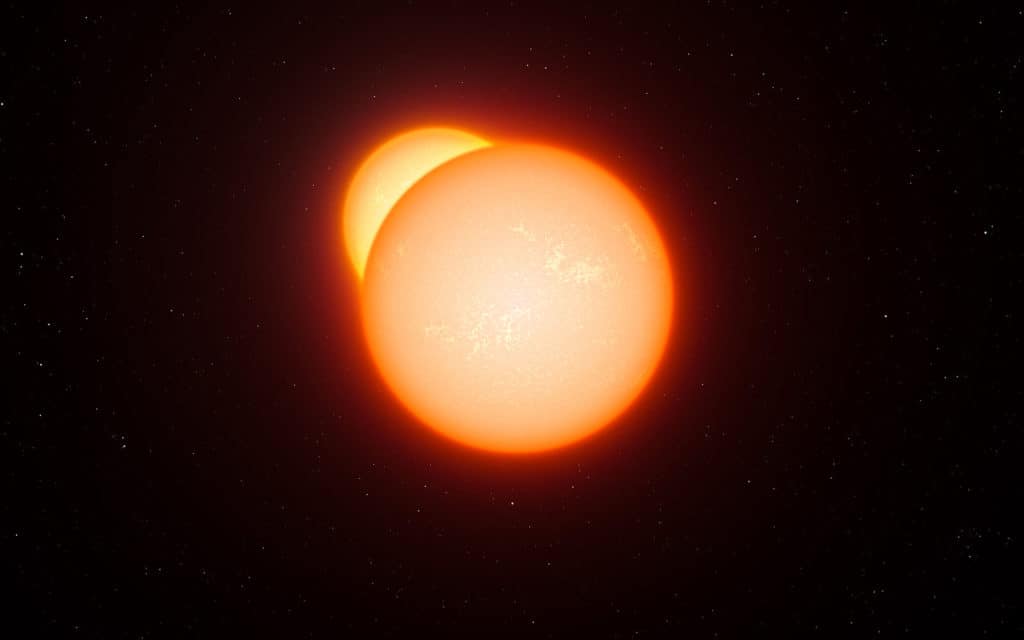
It was named as such due to its location in the constellation of Perseus, marking the head of the celestial medusa. Algol was also one of the 15 Behenian Fixed Stars, used in medieval times in magic rituals.
These stars were associated with planets, influencing them in an astrological sense. They were also associated with gemstones or plants which would bring the stars influence into magic rituals. In the case of Algol / Beta Persei, the star was associated with bad luck, death by decapitation, violence. The star was associated with the Saturn and Jupiter planets, the diamond gemstone, and the black hellebore plant.
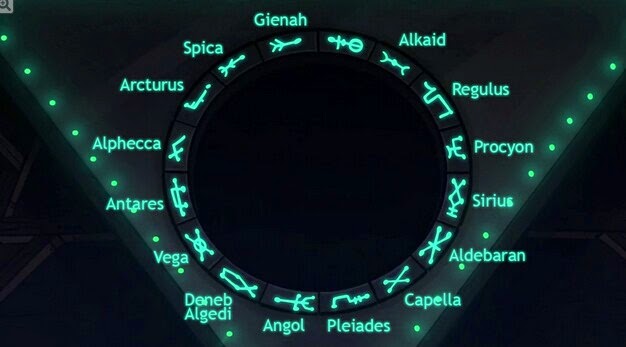
Formation
Beta Persei’s origin is currently unknown because the star isn’t associated with any moving star group. The primary star is speculated to have around 570 million years. It is possible that the star’s in the Beta Persei system may have formed at the same time or shortly after one another.
Beta Persei most likely formed out of a molecular cloud of dust and gas. Gravity pulled the swirling gas and dust together and resulted in the Demon Star that we today now see.
Since Beta Persei was more accurately studied, it led to the Algol Paradox. The star system seemed to evolve in a manner that defied established theories of stellar evolution.
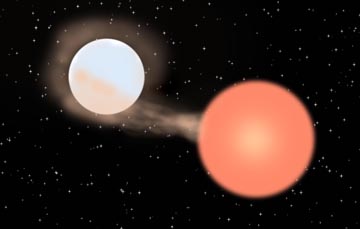
Based on a star’s mass, the greater it is the faster it will evolve off the main sequence but this doesn't apply to Beta Persei. Though Beta Persei Aa1 and Aa2 formed roughly at the same time, the primary star which is the most massive in its system, is still on the main sequence while the least massive has evolved into a subgiant.
This paradox is only explained through mass transfer. A phenomenon that is now accepted as quite common in binary systems. The secondary component was not always the leas massive but the flow of material between the two stars disturbed the normal evolution process.
Distance, Size, and Mass
The Beta Persei star system is located at around 90 light-years / 28 parsecs away from the Sun. Beta Persei is bright enough to be visible to the naked eye and many enthusiasts try to observe its eclipsing periods.
The primary star, Beta Persei Aa1, is the biggest star in its system and it has around 3.17 solar masses or 317% of the sun’s mass, and around 2.73 solar radii or 273% of the sun’s radius.

The secondary star, Beta Persei Aa2, is the smallest star in the system, having around having 0.70 solar masses or 70% the sun’s mass, and around 3.48 solar radii, or 348% the sun’s radius.
The third star, Beta Persei Ab, has 1.76 solar masses or 176% of the sun’s mass, and around 1.73 solar radii or 173% of the sun’s mass.
Other Characteristics
The primary star, Beta Persei Aa1, is a blue main-sequence star of spectral type B8V. Its average surface temperatures have been estimated to be at around 13.000 K. It is the hottest star in the system and it is 2.2 times hotter than our sun. Its surface gravity has been estimated at around 4.0 cgs.
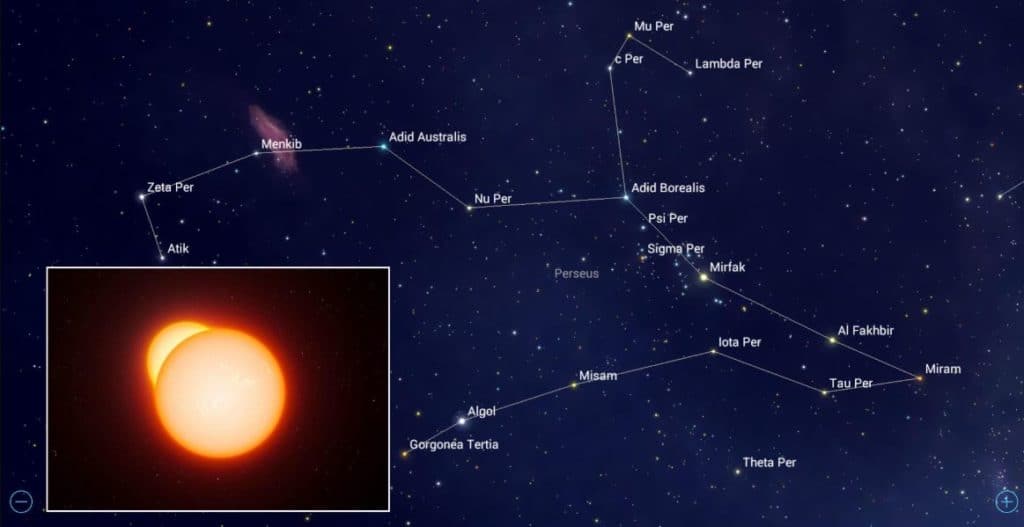
The star is a fast spinner, having a rotational velocity of around 49 km / 30.4 mi per second. It is also 182 times brighter than our sun, and the brightest in its system. Its absolute magnitude is -0.07.
The secondary star, Beta Persei Aa2, is an orange subgiant star of spectral type K0IV. It is much fainter and cooler than the primary star having surface average temperatures of around 4.500 K, much cooler than our sun, and shines with only 6.92 solar luminosities. The star’s surface gravity has been estimated to be at around 3.5 cgs and its absolute magnitude is estimated at 2.9.
The third star, Beta Persei Ab, is an A-class star of spectral type A7m. It is 10 times brighter than our sun and has a surface gravity of 4.5 cgs. The star’s temperature has been estimated at around 7.500 K, this is 1.2 times hotter than our sun. Its absolute magnitude is 2.3.
Stellar System
The stars Beta Persei Aa1 and Beta Persei Aa2 form a binary pair. They are close to each other, being separated on an average distance of 0.06 AU or 1/17 of the distance between Earth and the Sun.
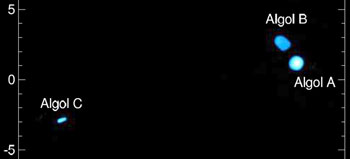
They orbit each other quite fast within a period of 2 days-20 hours-49 minutes, their orbit’s eccentricity is 0. When they pass in front of each other eclipses occur. The star system’s usual apparent magnitude is 2.1, but when the fainter star passes in front of the primary star the magnitude drops to 3.4. When the brighter star passes in front of the secondary star a secondary eclipse occurs but it can only be detected photoelectrically.
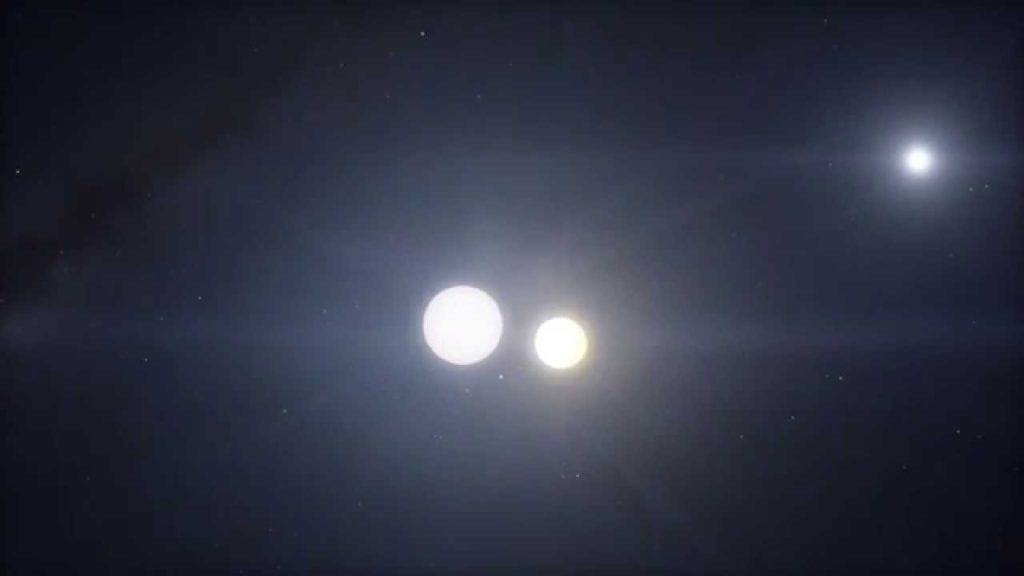
The third component of the star system revolves around the main binary system once every 1.85 years. What distinguishes Beta Persei from other variable star systems, is that Algol-type stars have a spherically or slightly ellipsoidal shape. The component stars are very closer to one another and this causes deformations in their shape.
The star system exhibits X-ray and radio wave flares. It is speculated that the x-ray flares are caused by the magnetic fields of the two stars interacting with their mass transfer. Their magnetic fields are around 10 times stronger than that of the suns.
Location
Beta Persei is located in the constellation of Perseus, the celestial mythological Greek hero of the same name. It is the most well-known star of the constellation marking the head of the celestial Medusa.
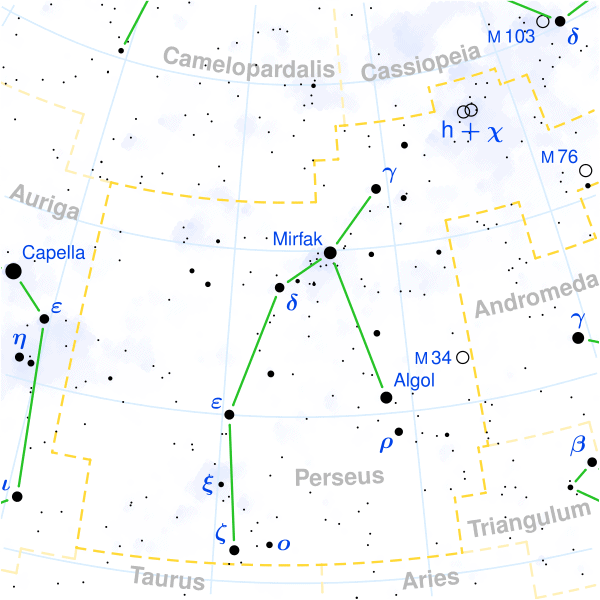
This constellation is one of the 48 recorded constellations of the Greco-Roman astronomer Ptolemy in his 2nd century Almagest. Though the constellation itself was known for many years before.
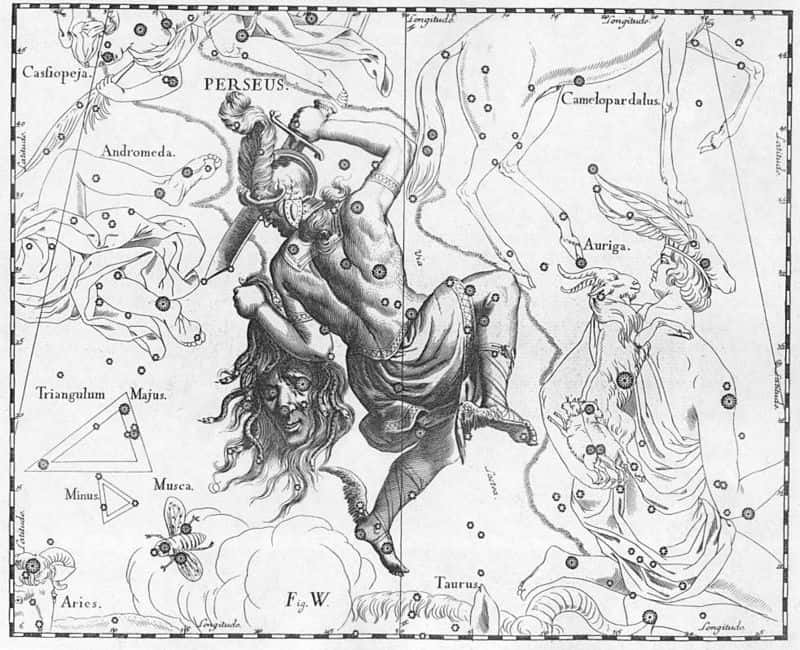
The Future
Though Beta Persei has been thoroughly studied, it continues to capture our imagination. The star will eventually suffer a core-collapse and as its temperatures will rise, its outer layer will expand outwards as it happens with its companion Beta Persei Aa2.
Did you know?
- The medieval Arabic commanders would try to ensure that no important battles would take place while Algo’s light was weak.
- Most astrologers would say that the star was the most unfortunate, violent, and dangerous star in the heavens.
- Algol is one of the most observed stars in the northern sky and the most noteworthy variable star.
- The eclipses on Beta Persei can be observed without a telescope.
- Around 7.3 million years ago, Beta Persei was only 9.8 light-years away from us and its apparent magnitude was -2.5, much brighter than Sirius is today. It is believed that the star’s passing caused gravity perturbations in the Oort Cloud and thus increased the number of comets entering the inner Solar System.
- Ptolemy listed Beta Persei in the 2nd century Tetrabiblos, as the Gorgon of Perseus.
- The Chinese knew Beta Persei as the Fifth Star of Mausoleum – an asterism formed by many stars of the Perseus constellation.
Sources:
Image source:
- https://cosmicpursuits.com/wp-content/uploads/2018/09/1600px-Artist%E2%80%99s_impression_of_eclipsing_binary.jpg
- https://cayelincastell.com/wp-content/uploads/2017/10/behenian-star-glyphs.jpg
- https://s22380.pcdn.co/wp-content/uploads/Algol-model-B-King-ST.jpg
- https://www.constellation-guide.com/wp-content/uploads/2019/04/Algol.jpg
- https://cdn.mos.cms.futurecdn.net/e3AYkGPcfNCgNCNyy75fXV.jpg
- https://alcognitio.altervista.org/wp-content/uploads/2016/01/Algol-e1454154028204.jpg
- https://upload.wikimedia.org/wikipedia/commons/8/86/Algol_triple_star_system_imaged_with_the_CHARA_interferometer.jpg
- https://i.ytimg.com/vi/hJ9zpvm7slo/maxresdefault.jpg
- https://upload.wikimedia.org/wikipedia/commons/thumb/e/ef/Perseus_constellation_map.svg/600px-Perseus_constellation_map.svg.png
- https://en.wikipedia.org/wiki/Algol#/media/File:Perseus_Hevelius.jpg
